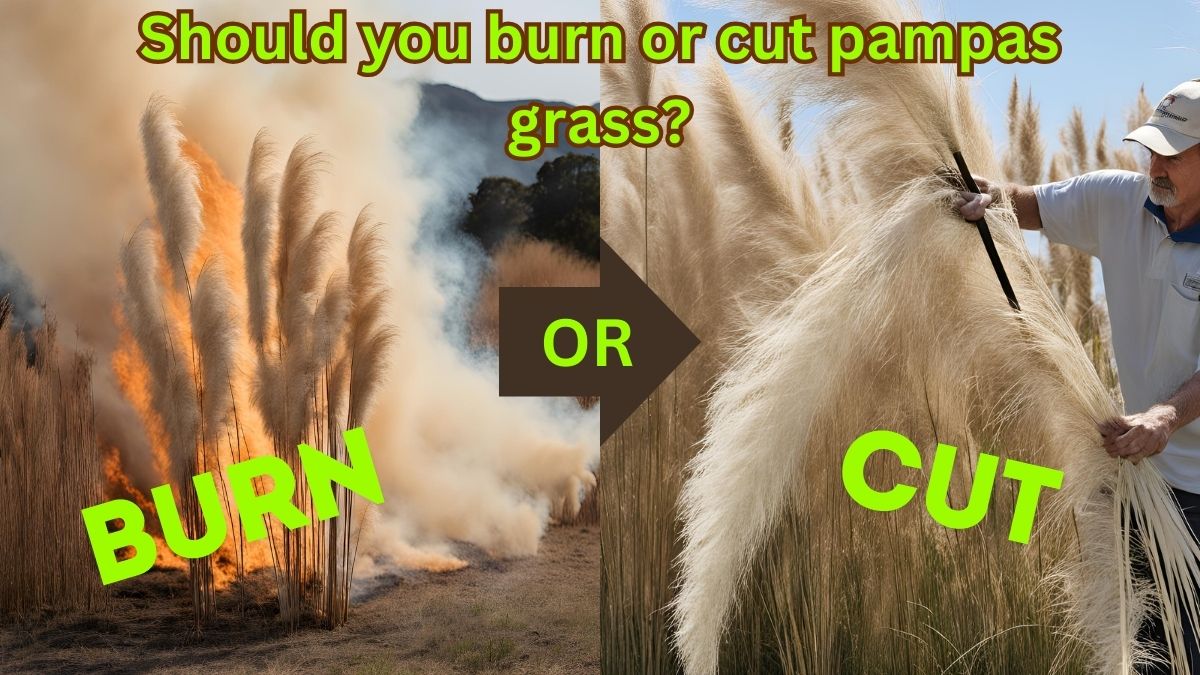Should you burn or cut pampas grass? Pampas grass, a plant native to South America, has become a popular landscaping choice worldwide due to its tall, feathery plumes and easy maintenance. However, when it comes to managing overgrown or unwanted pampas grass, homeowners often find themselves at a crossroads: should they burn or cut it? This blog post aims to explore these two methods, weighing their pros and cons, and providing you with the best practices for each. Whether you’re a seasoned gardener or a beginner, this guide will help you make an informed decision about managing your pampas grass effectively and safely. Let’s dive in!
Importance of Maintaining Pampas Grass
Maintaining Pampas Grass is crucial for several reasons:
1. Health of the Plant: Regular maintenance ensures the health and longevity of the plant. Overgrown or neglected pampas grass can become a breeding ground for pests and diseases. Regular trimming, watering, and fertilizing can help prevent these issues and promote healthy growth.
2. Safety: Pampas grass can grow quite tall and thick, which can pose a fire hazard if not properly maintained. Regular trimming reduces this risk. Also, the sharp edges of the grass blades can cause injury if not properly managed.
3. Aesthetics: Well-maintained pampas grass is visually appealing. It adds texture and movement to the landscape with its tall, feathery plumes and can be a focal point in the garden. Regular maintenance keeps the plant looking its best.
4. Control of Spread: Pampas grass can spread quickly and become invasive if not regularly maintained. By keeping the plant trimmed and removing any seed heads, you can prevent it from spreading uncontrollably.
Aesthetic and Health Benefits of Well-Maintained Pampas Grass:
1. Visual Appeal: Well-maintained pampas grass enhances the beauty of your garden. Its tall, feathery plumes sway gracefully in the wind, adding movement and texture to your landscape. It can serve as an attractive backdrop for other plants or as a stunning focal point.
2. Privacy: Pampas grass can provide a natural screen for privacy when planted in a row. It can hide unsightly views and create a sense of seclusion.
3. Habitat for Wildlife: Pampas grass can provide shelter for birds and other wildlife. However, it’s important to note that some species may be considered invasive and could potentially harm local ecosystems.
4. Stress Relief: Gardening, including the maintenance of pampas grass, can be a great stress reliever. The act of caring for plants can provide a sense of accomplishment and improve mood.
5. Air Quality: Like all plants, pampas grass contributes to improving air quality by absorbing carbon dioxide and releasing oxygen.
Burning Pampas Grass
Burning Pampas Grass can indeed be a quick and effective method to remove old growth and rejuvenate the plant. However, it’s important to consider both the pros and cons of this method:
Pros:
- Quick Removal of Old Growth: Burning can quickly clear out old, dead growth, making way for new shoots.
- Rejuvenation: The heat can stimulate the growth of new shoots, potentially leading to a healthier and more vibrant plant.
Cons:
- Potential Safety Hazards: Fire can quickly get out of control, especially in dry conditions. It’s crucial to have safety measures in place and to never leave a fire unattended.
- Environmental Concerns: Smoke from burning can contribute to air pollution. Additionally, fires can potentially harm local wildlife or other plants.
If you choose to burn Pampas Grass, here are some safety tips to consider:
Safety Tips:
- Check Local Regulations: Some areas have strict rules about open fires. Always check with local authorities or fire departments before starting a fire.
- Prepare the Area: Clear the area around the Pampas Grass of any flammable material to prevent the fire from spreading.
- Have a Water Source Ready: Always have a water source nearby in case the fire gets out of control.
- Monitor the Fire: Never leave the fire unattended. Monitor it until it has completely burned out and cooled down.
Cutting Pampas Grass
Cutting Pampas Grass is a safer alternative to burning and can also promote the health of the plant. Here are some benefits and techniques for this method:
Benefits:
- Encourages Healthy New Growth: Cutting back the old growth allows sunlight to reach the base of the plant, promoting the growth of new shoots.
- Reduces Risk of Fire Hazards: By removing the old, dry growth, you can reduce the amount of flammable material and decrease the risk of fire hazards.
Best Techniques:
- Wear Protective Gear: Pampas Grass can be sharp, so it’s important to wear long sleeves, gloves, and eye protection.
- Choose the Right Time: The best time to cut back Pampas Grass is in late winter or early spring, before new growth starts.
- Use Sharp Tools: Use a sharp, sturdy pair of pruning shears or a hedge trimmer for smaller clumps. For larger clumps, a chainsaw may be necessary.
- Cut Close to the Ground: Try to cut the grass down to about 6 inches from the ground.
- Dispose of the Cuttings Safely: Be sure to dispose of the cuttings in a safe manner to prevent any potential fire hazards.
Recommended Tools and Equipment:
- Pruning Shears: For smaller clumps of Pampas Grass.
- Hedge Trimmer: Can make the job quicker for medium-sized clumps.
- Chainsaw: For very large clumps of Pampas Grass.
- Safety Gear: Gloves, long sleeves, and eye protection are recommended.
Seasonal Care Guide
Caring for Pampas Grass involves different maintenance tasks throughout the year. Here’s a seasonal guide to help you prepare your Pampas Grass for different weather conditions:
Spring:
- Pruning: Cut back the grass to about 6 inches from the ground in late winter or early spring. This helps to remove old growth and make way for new shoots.
- Fertilizing: Fertilize the plant in early spring to encourage new growth.
- Watering: Water new plants deeply but let rainfall nourish established plants.
Summer:
- Watering: Pampas grass is drought tolerant. Established grasses should receive plenty of water from natural rainfall unless there is an extreme drought.
- Monitoring: Keep an eye on the plant during the hot summer months to ensure it’s not showing signs of distress, such as wilting or browning.
Fall:
- Preparation for Winter: Cut back old foliage and flower stalks in late fall. Spread mulch around the base and cover with burlap in colder regions.
- Fertilizing: Fertilize the plant at the beginning of fall during the first year.
Winter:
- Overwintering: Remove burlap in early spring. In colder regions, the plant can withstand some snow.
- Pruning: Prune the plant in late winter or early spring.
Does Pampas Grass Grow Back After Cutting?
Expert Tips for Optimal Upkeep
Here are some expert tips for optimal upkeep of Pampas Grass and common mistakes to avoid:
Expert Tips:
- Location: Pampas grass thrives in full sun, so select a location that gets at least six hours of sunlight a day.
- Soil and Watering: While it’s tolerant of a variety of soil types, pampas grass prefers well-draining soil. Water the plant regularly during its first growing season to help establish the root system. Once established, it’s drought-tolerant and needs only occasional watering.
- Spacing: This grass can reach impressive sizes, so ensure it has enough space to grow. Plant pampas grass at least 6 to 8 feet (1.8-2.4 meters) apart from other plants to avoid overcrowding.
- Pruning: In early spring, before new growth begins, cut back the old foliage to about a foot above the ground.
- Fertilizing: For abundant growth, feed the Pampas Grass a balanced fertilizer four times a year.
Common Mistakes to Avoid:
- Overwatering: One of the biggest mistakes you can make is overwatering your Pampas grass. While it’s true that Pampas grass needs water to survive, too much water can actually harm the plant.
- Ignoring signs of disease or pests: Pampas grass can be affected by various diseases and pests, especially in winter. If you notice any changes in your Pampas grass, such as yellowing leaves or holes in the blades, it’s important to take action immediately.
- Wrong Timing: Dividing Pampas Grass at the wrong time can stress the plant. Stick to the recommended division seasons.
- Excessive Division: Avoid dividing too aggressively, as it can weaken the plant.
- Over-Fertilizing: Refrain from applying too much fertilizer, especially immediately after division.
- Pruning at the wrong time: One such mistake is pruning at the wrong time, which can stunt the plant’s growth and cause it to look unkempt.
Conclusion
In conclusion, between burning and cutting Pampas Grass, both methods have their own merits and drawbacks. Burning can quickly remove old growth and rejuvenate the plant, but it comes with potential safety hazards and environmental concerns. On the other hand, cutting encourages healthy new growth and reduces the risk of fire hazards, but it requires more effort and the right tools.
FAQs
Here are some FAQs:
- What is pampas grass and why is it a concern? Pampas grass, or Cortaderia selloana, is a tall, perennial grass native to South America that has been introduced to many parts of the world as an ornamental plant. It’s a concern because it can grow very large, outcompeting native plants for resources. Its dense growth can also pose a fire hazard.
- What are the pros and cons of burning pampas grass? Burning pampas grass can be an effective way to quickly remove large amounts of the plant. The heat can kill seeds and roots, preventing regrowth. However, burning also poses risks. It can be dangerous if not controlled properly, potentially causing wildfires. It also contributes to air pollution and can harm local wildlife.
- What are the pros and cons of cutting pampas grass? Cutting pampas grass is a safer method than burning. It can be done at any time and doesn’t pose a fire risk. However, it can be labor-intensive, especially for large infestations. Cutting also needs to be done regularly to prevent the grass from regrowing. Additionally, the sharp edges of the grass can cause injuries if not handled carefully.
- Are there any alternatives to burning or cutting pampas grass for its control? Yes, there are alternatives. One method is to use herbicides, which can be effective but also have potential environmental impacts. Another method is biological control, using natural enemies of the plant to reduce its population. This method requires careful research to ensure the control species won’t become a problem itself.


